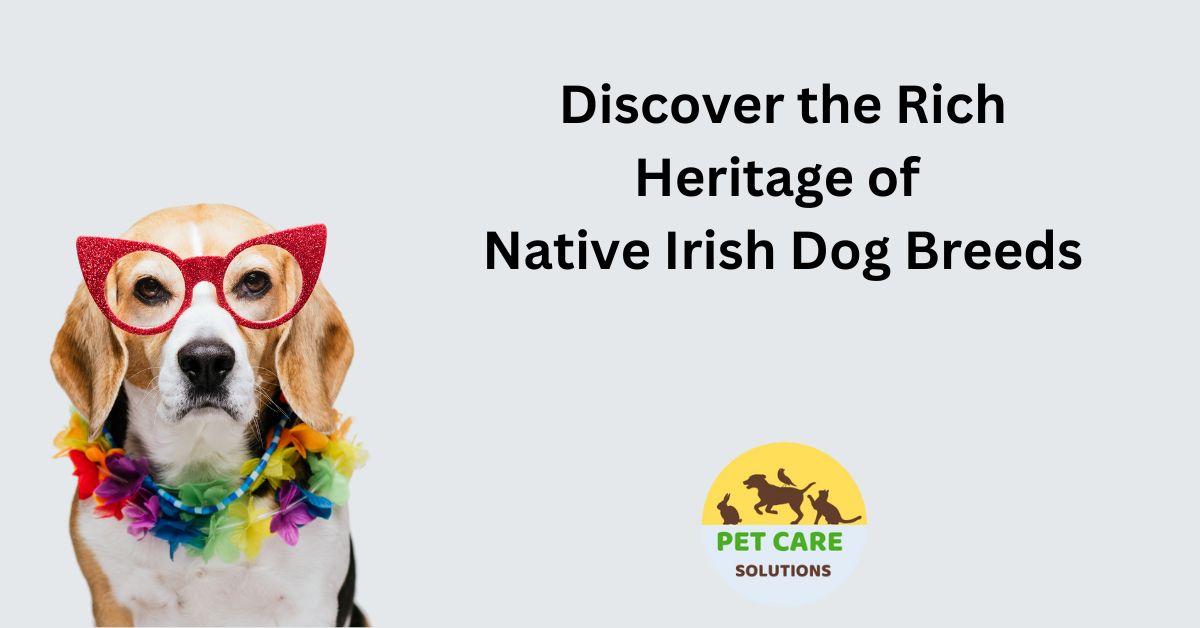There are nine Native Dogs of Ireland, two Hounds – Irish Wolfhound and Kerry Beagle, three Gundogs – Irish Water Spaniel, Irish Red Setter and Irish Red & White Setter, four Terriers – Irish Terrier, Irish Glen of Imaal Terrier, Irish Soft Coated Wheaten Terrier, Kerry Blue Terrier.
Each of these breeds has its own unique characteristics and traits that make them well-suited to various roles, such as hunting, guarding, and companionship. The Irish Wolfhound is a gentle giant known for its size and strength, while the Kerry Beagle is a skilled scent hound used for hunting. The Irish Water Spaniel is a versatile waterfowl retriever, the Irish Red Setter is known for its distinctive red coat and friendly demeanour, and the Irish Red & White Setter is a close relative of the Irish Red Setter with a similar hunting ability.
The Irish Terrier is a bold and lively breed with a strong prey drive, the Irish Glen of Imaal Terrier is known for its unique appearance and calm disposition, the Irish Soft Coated Wheaten Terrier is a happy-go-lucky breed with a silky coat, and the Kerry Blue Terrier is a spirited and intelligent breed used for hunting and guarding.
Overall, the Irish Dog Breeds are a diverse group of breeds with a rich history and unique characteristics that make them beloved companions and working dogs for their owners.
That’s correct! Ireland is known for its rich canine heritage, and these nine native breeds showcase the country’s diverse and specialized dog breeds. Let’s break them down again:
Discover the Rich Heritage of Native Irish Dog Breeds
1. Irish Wolfhound
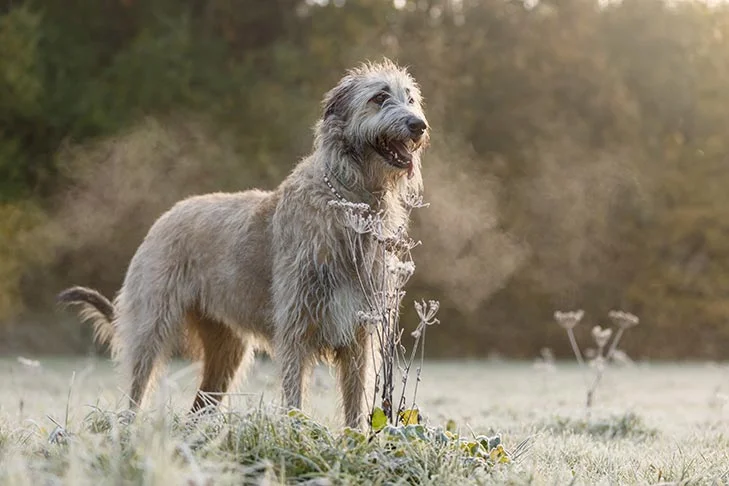
This is one of the tallest dog breeds in the world, originally bred for hunting wolves and elk. Absolutely, the Irish Wolfhound is indeed one of the tallest dog breeds in the world. Known for their impressive size and stately appearance, these gentle giants were originally bred for hunting wolves, elk, and other large game in Ireland. Adult males typically stand at least 32 inches tall at the shoulder, and some can even reach heights of up to 35 inches or more. Despite their formidable size and history as hunters, Irish Wolfhounds are known for their calm and friendly temperament, making them wonderful companions. However, their large size means they require plenty of space and exercise to stay healthy and happy.
2. Kerry Beagle
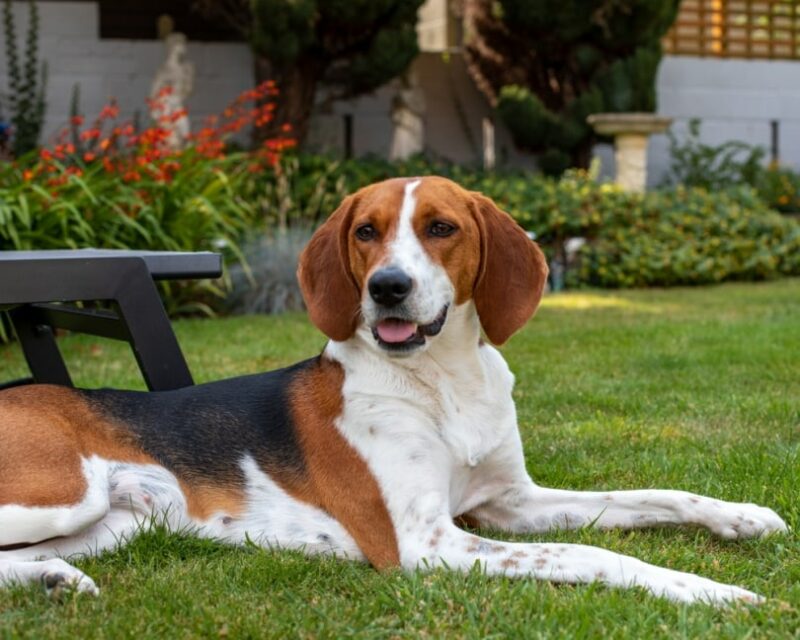
Despite its name, it’s considered one of the oldest Irish hound breeds, known for its excellent tracking ability. The Kerry Beagle is indeed a fascinating breed with a rich history. Contrary to what its name might suggest, it is not closely related to the Beagle as we know it today. Instead, the Kerry Beagle is considered one of the oldest hound breeds native to Ireland, with a lineage that some suggest could date back to the Celtic era.
This breed is known for its exceptional tracking abilities, making it a superb hunting dog. Traditionally, Kerry Beagles were used in stag and fox hunting, prized for their endurance, keen nose, and relentless pursuit of game. They typically have a lean, muscular build, contributing to their agility and speed, essential traits for a hunting companion.
Kerry Beagles often have a friendly and intelligent disposition, making them good family pets, provided they get plenty of exercise to meet their high energy levels. Their short coat can come in various colours, including black and tan, blue mottled with black, and solid colours like black or tan.
Overall, the Kerry Beagle remains a versatile and robust breed, highly valued for both its work ethic in the field and its loyal nature at home.
3. Irish Water Spaniel
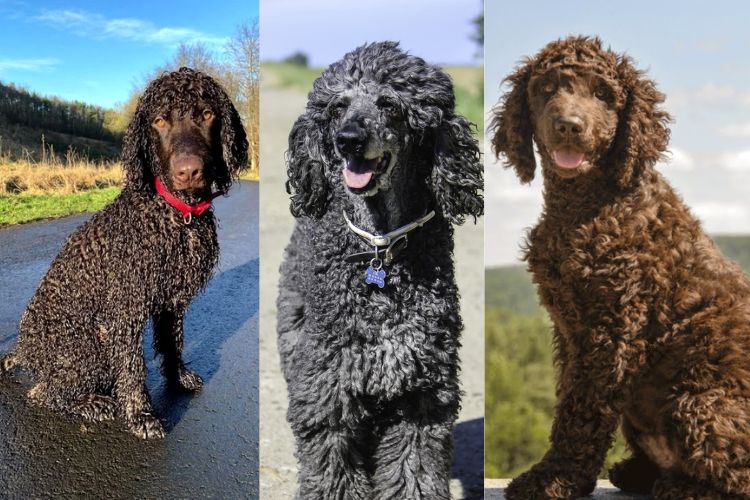
Recognizable by its curly coat and known for its excellent swimming ability, this breed is used in retrieving game from water. The Irish Water Spaniel is indeed a distinctive and versatile breed. Known for its unique curly coat that provides excellent protection and insulation in the water, the Irish Water Spaniel is highly adept at retrieving game from aquatic environments. This breed has a long history of working closely with hunters, displaying both intelligence and a strong work ethic.
One of the most striking features of the Irish Water Spaniel is its dense, curly coat, which is water-resistant and helps protect the dog from cold temperatures while swimming. The coat is typically liver-coloured and requires regular grooming to maintain its condition and prevent matting.
Irish Water Spaniels are also known for their characteristic “rat tail,” which is smooth and sparsely covered with hair compared to the rest of their coat. This unique feature aids in their swimming efficiency by acting almost like a rudder.
In terms of personality, Irish Water Spaniels are generally active, playful, and intelligent. They are quick learners and require regular mental and physical exercise to keep them engaged and happy. Their excellent swimming ability, coupled with their energetic nature, makes them well-suited for families who enjoy outdoor activities, particularly those involving water.
Overall, the Irish Water Spaniel is a unique and versatile breed that excels in both working and family environments due to its physical capabilities and engaging personality.
4. Irish Red Setter
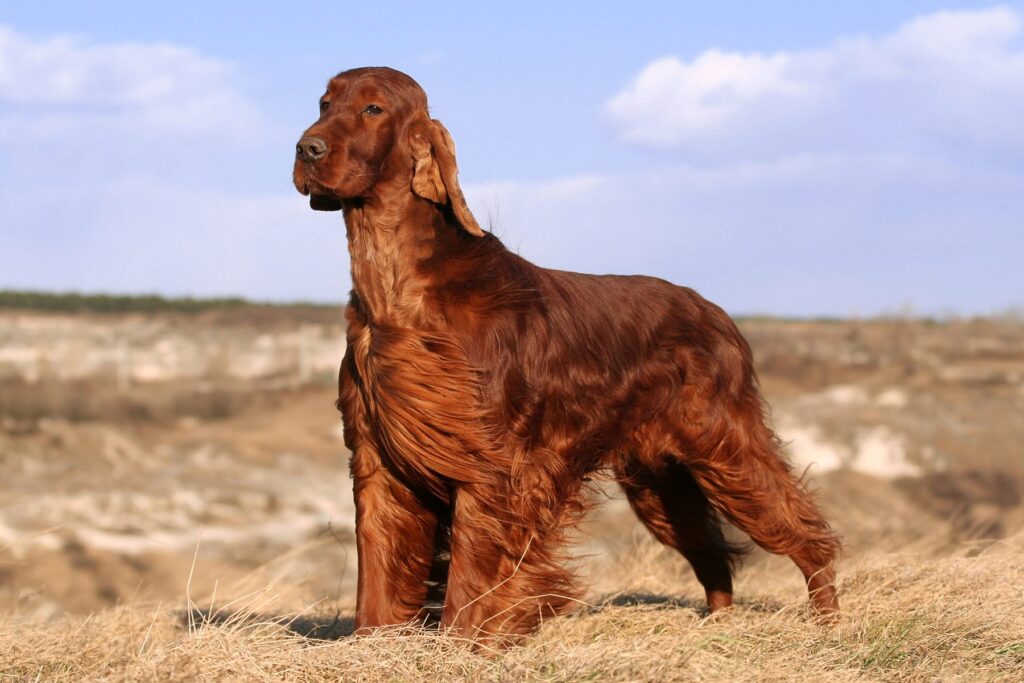
Known for its solid red coat, this energetic and friendly breed is a popular choice for hunting and as a family pet. The Irish Red Setter, often simply referred to as the Irish Setter, is a striking and elegant breed known for its solid red coat, which ranges from a deep chestnut to a rich mahogany colour. This energetic and friendly breed is renowned for its exuberant personality, intelligence, and versatility.
Originating in Ireland during the 18th century, the Irish Setter was developed primarily for bird hunting, particularly for game such as quail, pheasant, and grouse. Their keen sense of smell, remarkable speed, and ability to cover ground quickly made them exceptional hunting companions. Their elegance and striking appearance also made them stand out in the show ring.
In addition to their hunting prowess, Irish Setters are beloved family pets. They are known for their affectionate nature and strong bonds with their families. Their friendly disposition makes them excellent companions for children and other pets. However, they are high-energy dogs that require regular and vigorous exercise to keep them happy and healthy. Activities like running, hiking, and engaging in dog sports can help satisfy their physical and mental needs.
Training an Irish Setter can be a rewarding experience, as they are intelligent and eager to please. However, they can also be a bit stubborn and independent, so consistent and positive reinforcement methods are most effective. Early socialization and training are essential to help them grow into well-rounded adults.
The Irish Setter’s luxurious coat requires regular grooming to keep it in top condition. This includes brushing several times a week to prevent matting and tangling, as well as occasional trimming to keep their coat neat and manageable.
Overall, the Irish Setter is a beautiful, lively, and affectionate breed that thrives in active households where they can participate in family activities and enjoy plenty of exercise. Whether as a hunting companion or a loyal family pet, they bring joy and enthusiasm to their owners’ lives.
5. Irish Red and White Setter

Similar to the Irish Red Setter but with a distinctive red and white coat, this breed is also used for hunting. The Irish Red and White Setter is indeed a distinguished and versatile breed, celebrated for its hunting prowess as well as its distinct appearance. Often compared to the more widely recognized Irish Red Setter, the Irish Red and White Setter sets itself apart primarily through its unique coat pattern, which combines patches of solid red with clear, defined white areas.
Characteristics:
1. Appearance:
– Coat: The coat is mostly white with solid red patches, distinct from the uniformly red coat of the Irish Red Setter.
– Build: They have a strong, athletic build, designed for stamina and agility in the field.
2. Temperament:
– Friendly and Affectionate: These dogs are known for their friendly disposition, making them excellent companions for families.
– Intelligent and Trainable: Their intelligence and eagerness to please make them relatively easy to train.
– Energetic and Enthusiastic: Being a hunting breed, they require ample exercise and mental stimulation to keep them happy and healthy.
3. Hunting Abilities:
– Excellent Scents: These dogs possess exceptional scenting abilities, which they use to locate game.
– Versatile Hunters: They can be used to hunt a variety of game birds, making them versatile field dogs.
– Steadiness and Precision: Their ability to remain steady and point accurately is highly valued in hunting scenarios.
4. Health:
– Generally Healthy: They are generally a healthy breed, but, like all breeds, can be susceptible to certain genetic conditions. Regular veterinary check-ups are important.
– Lifespan: Typically live between 10-14 years with proper care.
Care Requirements:
1. Exercise:
– Daily Activity: They require substantial daily exercise. Activities such as long walks, running, and engaging in hunting or field trials are ideal.
– Mental Stimulation: Puzzle toys, obedience training, and other mentally-stimulating activities help prevent boredom and associated behaviours.
2. Grooming:
– Routine Brushing: Regular brushing is necessary to keep their coat in good condition and to prevent matting.
– Occasional Bathing: Only bathe when necessary to maintain coat health.
3. Training:
– Consistency and Patience**: Use positive reinforcement techniques to train these intelligent and eager-to-please dogs.
– Early Socialization**: Expose them to different environments, people, and other animals from a young age to develop a well-rounded demeanour.
History:
The Irish Red and White Setter is an ancient breed, believed to be the original Irish setter before the development of the solid red variety. The breed faced a decline during the 19th and 20th centuries but has since seen a resurgence thanks to breed enthusiasts and dedicated breeding
6. Irish Terrier
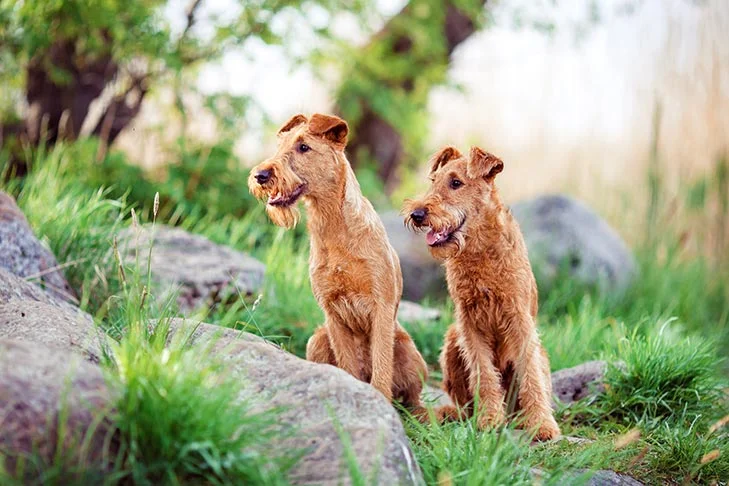
One of the oldest terrier breeds, known for its red coat and good temperament. Absolutely! The Irish Terrier is indeed one of the oldest and most distinctive terrier breeds, known not only for its striking red coat but also for its spirited, loyal, and affectionate nature. Here are a few more key points about this charming breed:
Physical Characteristics
– Coat: Dense and wiry, the coat is typically a beautiful red, but can also be seen in shades of red wheaten or golden red.
– Size: A medium-sized dog, Irish Terriers generally weigh between 25 to 27 pounds (11 to 12 kg) and stand about 18 inches (46 cm) tall at the shoulder.
– Appearance: The breed has a graceful and athletic build. Their expressive eyes and keen, alert expression add to their charm.
Temperament
– Affectionate and Loyal: Irish Terriers are known for their deep loyalty and affection towards their families. They are especially good with children, often earning the nickname “nanny dog.”
– Brave and Spirited: True to their terrier roots, they are brave and spirited, displaying a confident and determined personality.
– Intelligent: They are quick learners and respond well to consistent training. However, they can be independent and sometimes a bit stubborn.
History
– Origins: The breed is believed to have originated in Ireland, with some records suggesting its presence as far back as the 17th century.
– Utility: Traditionally, these dogs were used for various purposes, including hunting small game, guarding homes, and serving as versatile all-around farm dogs.
Care and Maintenance
– Exercise: Irish Terriers are active and require regular physical activity to stay happy and healthy. Daily walks, playtime, and mental stimulation are essential.
– Grooming: Their wiry coat needs regular brushing to keep it tidy and free of tangles. Hand-stripping a couple of times a year is also recommended to maintain the coat’s texture.
– Health: Generally robust and healthy, but like all breeds, they can be prone to certain health issues. Regular vet check-ups and a good diet can help keep them in top shape.
The Irish Terrier’s combination of loyalty, courage, and charming personality make it a beloved choice among dog enthusiasts, especially those looking for a vigilant yet affectionate companion.
7. Irish Glen of Imaal Terrier
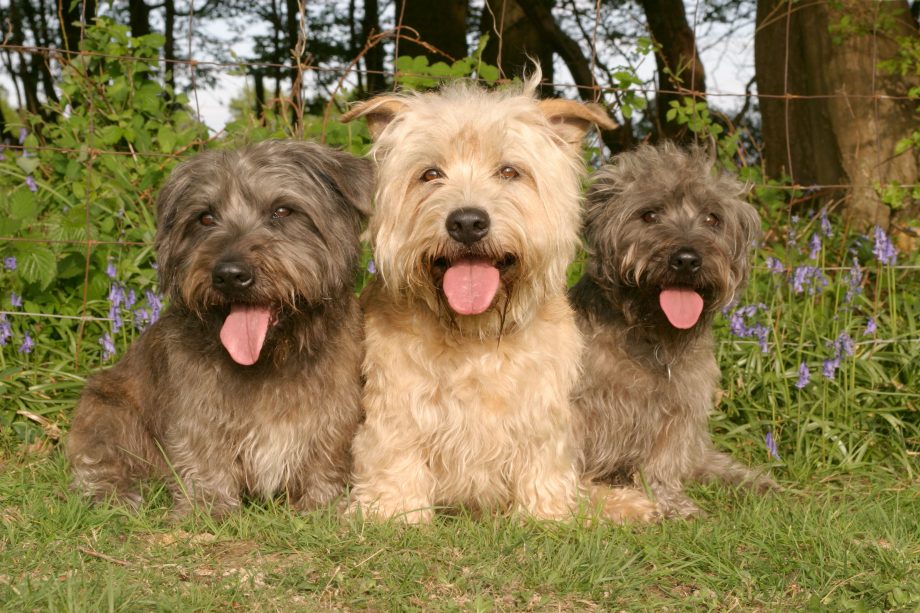
A strong and sturdy breed with a distinctive wheaten or blue brindle coat, originally bred for hunting and as a farm dog. The Irish Glen of Imaal Terrier is a small, robust breed known for its strength and rugged build. Hailing from the Wicklow Mountains in Ireland, this dog was originally bred for versatile farm work, including hunting vermin, badgers, and foxes, as well as assisting with general farm duties. It was also used in “turnspit” work, where it would walk on a treadmill to turn meat over a fire.
Key characteristics of the Irish Glen of Imaal Terrier include:
1. Appearance:
– Size: This breed is relatively small, typically weighing between 32 to 40 pounds. They stand about 12.5 to 14 inches tall at the shoulder.
– Coat: Their coat is unique and can be found in two dominant colours: wheaten (ranging from a light cream to a golden red) or blue brindle (a blue-Gray with black stripes). The coat is usually of medium length with a soft undercoat and a harsh, wiry outer coat.
– Body: They have a long body, short legs, and a broad head, which gives them a distinctive appearance. Their large, expressive eyes and sturdy build add to their charming yet determined look.
2. Personality:
– Irish Glen of Imaal Terriers are known for their brave and tenacious nature. They are confident and can be quite independent, yet they form strong bonds with their families and are known to be affectionate and loyal.
– While they are spirited hunters, they generally have a more laid-back demeanour compared to other terrier breeds, making them good companions for families.
– They are also known for their intelligence and can be trained well with consistent, positive reinforcement techniques.
3. Exercise and Care:
– Due to their working dog heritage, they require regular exercise to keep them physically and mentally stimulated. Daily walks and playtime are essential. They especially enjoy activities where they can use their hunting instincts, like games of fetch or scent trails.
– Regular grooming is needed to maintain their coat’s condition. Brushing a few times a week and occasional trimming will help keep their coat healthy and reduce shedding.
4. Health
– The breed is generally healthy, but some common health issues can include hip dysplasia and progressive retinal atrophy. Regular veterinary check-ups and a healthy diet can help maintain their well-being.
With their charming mix of ruggedness and affection, the Irish Glen of Imaal Terrier makes for a devoted and delightful companion, especially for those who can appreciate its unique blend of strength and tranquillity.
8. Irish Soft Coated Wheaten Terrier
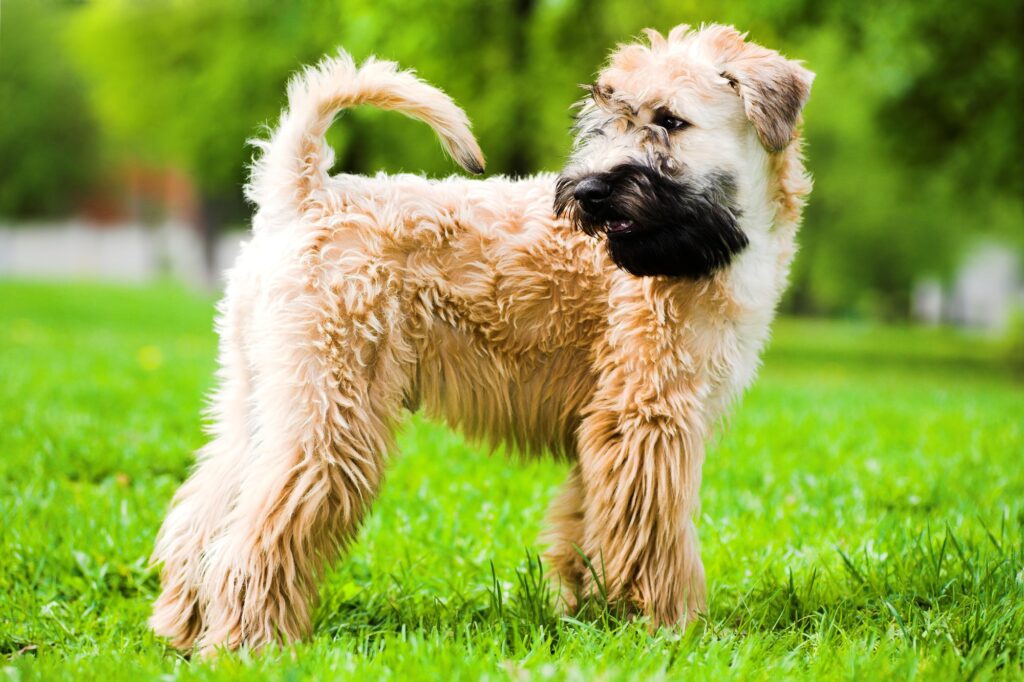
Known for its soft, silky coat and friendly disposition, making it a beloved family pet. The Irish Soft Coated Wheaten Terrier is indeed a delightful breed, renowned for its soft, silky coat and friendly, outgoing temperament. Originally bred in Ireland as an all-purpose farm dog, the Wheaten Terrier excels in activities like herding, guarding, and hunting vermin. Over time, it has also become a cherished companion pet, thanks to its affectionate and friendly nature.
Here are some key characteristics and care tips for the breed:
Physical Characteristics
1. Size: Medium-sized. Typically, males stand about 18-19 inches tall at the shoulder and weigh around 35-40 pounds, while females are slightly smaller.
2. Coat: The coat is soft, silky, and wavy. It doesn’t shed much, making the breed a good choice for people with allergies.
3. Colour: The coat is wheaten-coloured, ranging from a pale beige to a shimmering gold.
Temperament
1. Friendly: Wheaten Terriers are well-known for their friendly and sociable nature. They’re usually good with children and other pets.
2. Energetic: They are active and energetic dogs who require regular exercise to stay happy and healthy.
3. Intelligent: This breed is quite smart and responds well to training, though they can sometimes be a bit stubborn.
Care Requirements
1. Grooming: Regular grooming is essential to keep their coat in top condition. This includes brushing a few times a week to prevent mats and tangles, and occasional professional grooming.
2. Exercise: Wheaten Terriers need daily exercise, such as walks, playtime, or agility training, to burn off their energy and stay fit.
3. Health: They are generally healthy, but like all breeds, they can be prone to certain genetic health issues. Regular vet check-ups and a balanced diet will help keep them in good health.
Training
1. Positive Reinforcement: They respond well to positive reinforcement methods, such as treats, praise, and play.
2. Socialization: Early socialization is important to expose them to different people, environments, and animals. This helps them grow up to be well-rounded dogs.
Living Conditions
1. Adaptability: While they can adapt to various living situations, including apartments, they thrive best in homes where they have space to run and play.
2. Fond of Companionship: They enjoy being around their family and can suffer from separation anxiety if left alone for long periods.
Overall, the Irish Soft Coated Wheaten Terrier makes a wonderful addition to many families due to its friendly disposition, manageable size, and relatively low-shedding coat. Proper care, training, and socialization can ensure that your Wheaten Terrier will be a happy and well-behaved member of the family.
9. Kerry Blue Terrier
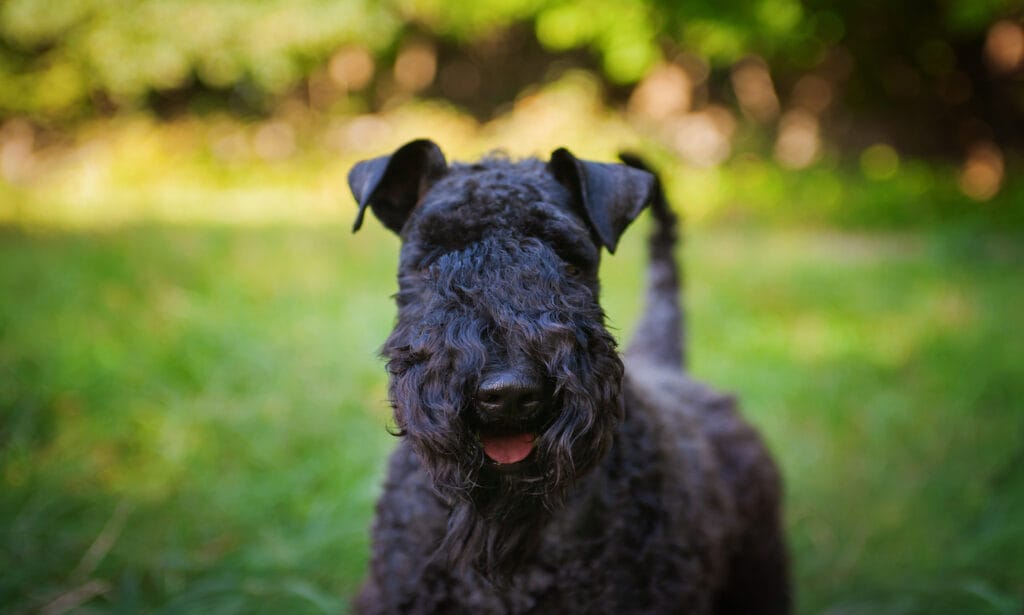
Renowned for its blue-Gray coat and versatility as a working dog and companion. The Kerry Blue Terrier, often simply called the Kerry, is celebrated for its distinctive blue-Gray coat, which can range in shade from a deep slate blue to a lighter silvery gray as the dog matures. Originating from County Kerry in Ireland, this breed has a rich history as a versatile working dog, excelling in tasks such as herding, hunting small game, and even guarding properties.
In addition to their working capabilities, Kerry Blue Terriers are also cherished as loyal and affectionate companions. They are known for their spirited and intelligent nature, making them highly trainable, though they can also exhibit a stubborn streak. Regular grooming is essential to maintain their unique coat, which does not shed heavily but can grow quite thick and curly.
Kerry Blues are a robust and energetic breed, requiring adequate exercise and mental stimulation. They tend to form strong bonds with their families and can be protective, making them excellent watchdogs. Proper socialization is important to ensure they get along well with other pets and strangers.
Overall, the Kerry Blue Terrier is a striking and versatile breed, known as much for its distinctive appearance as for its multifaceted abilities as both a working dog and a loving family member.
Frequently Asked Questions
What Are The Most Popular Native Irish Dog Breeds?
There are several native Irish dog breeds that dog lovers cherish. These include the Irish Wolfhound, known for being the world’s tallest dog breed, the Irish Setter, famed for its beautiful red coat, and the Irish Terrier, recognized by its wiry coat and spirited temperament. Other popular breeds from the Emerald Isle include the Irish Water Spaniel, Kerry Blue Terrier, and the Soft Coated Wheaten Terrier. Each of these breeds possesses unique characteristics that make them special in their own right.
What Makes The Irish Wolfhound So Special?
The Irish Wolfhound stands out due to its impressive size and noble demeanor. As the world’s tallest dog breed, this breed was originally used for hunting wolves and deer. Despite its imposing stature, the Irish Wolfhound has a gentle and friendly temperament. This combination of size, history, and demeanor makes it one of the most admired dog breeds among both dog lovers and breeders.
What Is Unique About The Irish Water Spaniel?
The Irish Water Spaniel is easily recognizable due to its curly coat and distinctive “rat tail.” This breed is one of the oldest spaniels and was originally used for retrieving game from water. With its keen intelligence and energy, the Irish Water Spaniel excels in dog sports and agility. It is also known for its affectionate nature and loyalty to its family.
How Did The Irish Terrier Earn Its Place Among Terrier Breeds?
The Irish Terrier is one of the oldest terrier breeds, known for its determination and adaptability. It has a distinctive wiry coat and a fearless personality, making it an excellent farm dog and loyal companion. The Irish Terrier is agile, brave, and protective, qualities that have kept it popular among dog lovers who value a spirited and versatile dog.
What Is The Role Of The Irish Kennel Club?
The Irish Kennel Club is responsible for the recognition and registration of dog breeds in Ireland. It plays a crucial role in organizing dog shows and events that promote responsible breeding and dog ownership. The club also sets standards for each breed and provides guidelines for their care and training. By supporting the preservation of native Irish dog breeds, the Irish Kennel Club helps maintain Ireland’s rich canine heritage.
What is Ireland’s national dog?
Ireland’s national dog is represented by several native dog breeds that have been a part of Irish life for centuries. Among the nine native breeds of Ireland, Irish native dogs like the Irish Soft Coated Wheaten Terriers and the Irish Terrier breeds stand out. These breeds of Ireland are known for their loyalty and agility, making them excellent companions for active families, especially those families with older children.
The Irish Soft Coated Wheaten Terriers, first recognized by the AKC, are celebrated for their distinctive curly coat, while the Irish Terrier breeds are recognized for their distinctive red fur and spirited personalities. These breeds of dogs have been integral to Irish life since ancient times, often celebrated in local culture and even during Patrick’s Day festivities.
The large breeds first recognized for their importance in rural settings include the majestic Irish Wolfhound, known for its “rat tail” and towering presence. Also, the Kerry Blue Terrier, hailing from the rugged landscapes of Ireland, is another example of an Irish native dog that make excellent companions. Although some might remain a rare breed beyond Ireland, they hold a special place in the hearts of many Irish.
The term “wolf” in the modern Irish language, or “cu,” reflects the deep historical connection these two Irish breeds have with their homeland’s heritage and culture. With the American Kennel Club helping to recognize and preserve these breeds, they continue to thrive and adapt even in contemporary times.
